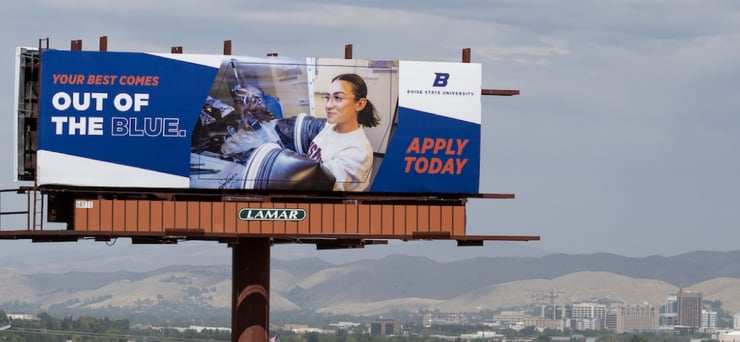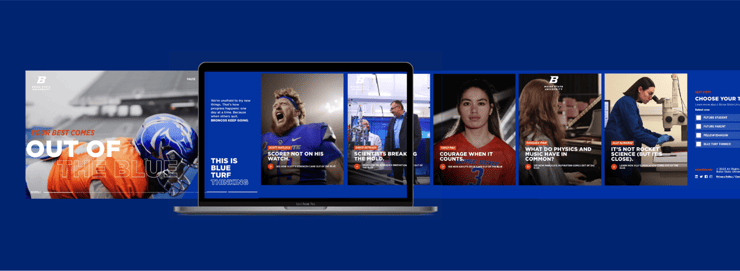Hello, Jason? This is your alma mater speaking.
It was not the easiest work for a freshman.
I can still picture my desk, wearing my little headset, casually getting rejected 11+ times for every “Sure, I’ll give!”.
For literal hours.
At the time, the $11/hour was the big draw — lucrative by most campus job standards and critical since I was footing the bill for college. But in hindsight, I learned two bigger lessons:
- Call center life prepped me for a career in creative work, thickening up my skin for the process of pitching multiple ideas and ultimately discarding all darlings but one.
- Fundraisers are superheroes. That experience gave me immense respect for what development officers do every day to build strong relationships with donors.
And that is why I take the process of supporting their work so seriously.
Do you have a minute? We’d love to update your information and tell you about what’s been happening on campus.
Most of us night-shifters clung tightly to the call script. We were all encouraged to add flavor. I’d dabble with variations to sound more me. But over time, I forged a strong bond with those talking points, a real lifesaver for newbies.
Thoughtful communications tools can help teams connect with people on a more human level. The script provided questions to consider: What were you into on campus? What are you doing now? How are you using your degree in architecture?
The paths alum take are always endlessly fascinating. Endlessly unique.
Interesting, then, how the conversation always drew to the same inevitable conclusion.
Would you consider supporting our students and programs tonight by making a tax-deductible gift of $100?
The caller knows it’s coming. You know it’s coming. Everyone’s bracing for it.
No to $100? No problem. How about showing your support with $50 dollars tonight?
I get it. It’s standard practice. It’s social psychology. If you don’t make the ask, you’ll never really know who’s willing to give at that moment.
That’s fine if $50 doesn’t work. We could get you in at our sustaining member level — will you join us by making a gift of just $25?
But what if all three asks weren’t all about the money?
Rethinking the Ask from Money Money Money to TLC: Time. Leadership. Cash.
Everyone who cares enough about a cause has something to give. That’s more than a financial statement. It’s a matter of engagement.
As SimpsonScarborough’s 2023 Alumni Philanthropy Study shows, people are way more likely to make a financial contribution to their alma mater if they’re already in touch with the institution in other ways. Recently, the president of a partner institution even told us, “I’d rather engage 100,000 people than hit some specific fundraising goal.” So if everyone’s path is different post-college, then every alum and thus their capacity to contribute is different.
The question then becomes how best to channel the passions of a committed alum who simply doesn’t have the $100, $50, or even $25 right this second. And the answer may be as simple as rethinking the ask.
Instead of going after money all three times, what if we used a framework that had empathy baked in? Give people the chance to tell you how they can show their support — “TLC” — without declining a donation three separate times:
- Give Time (Volunteer): Come to alumni events in your area; connect with faculty members and university leaders, etc.
- Give Leadership (Advice): Offer some of your talent and/or hard-earned wisdom and connections to support students or young alumni; serve as a strategic adviser to the institution; etc.
- Give Cash or Capital (Donate/Fund): Make a monetary donation to the institution in any form — endowment, annual fund, planned legacy programs, etc.
In this model, you flip the (literal) script in a way that puts common forms of engagement in their rightful place; at the top of the list. Cash is the last resort, not the only option. With the “Money, Money, Money” model, a donor can feel like there’s only one way to give. There’s making a cash gift, and then there’s everything else. So how might we use this insight to create more thoughtful — more empathetic — brand experiences for donors?
Meeting Donors Where They Are.
In their 2023 Wrap-Up Report, the good folks at Cannes Lions had this to say:
A dynamic approach is required to celebrate the power of brands and turn every touch point into an opportunity to engage.
That brings us to our partners at Cornell University, who have been singing the engagement song since launching the public phase of their campaign “To Do The Greatest Good” in 2021. The campaign’s financial goal is $6 billion. But the Cornell team’s moral objective was always to bring more Cornellians “into the tent” of engaging with the University. And 200,000 donors were also their big-picture goal, a mark they were 80% of the way toward hitting at just over the halfway point of the campaign.
Here are a few of the brand tools we helped them develop:
Storytelling that ‘crosses generations’ and invites Cornellians to ‘make history’ — from alumni to academic leaders to current students.
Check out specifically how the Cornell video concept “lets Cornell speak for itself,” building a grassroots feel that encourages participation more than giving by itself.
Visual hooks that evoke pride across departments and colleges.
Instead of leading with an aggressive financial ask, lead with a potential impact point that donors can connect with depending on their interests. Cornell told a wide enough range of these stories quickly and nonverbally that they were able to generate excitement and build momentum among alum audiences.
It began with a simple idea: The Cornell ‘C’ can become a frame for the people, programs, and potential you (as a donor) can support in this campaign.
Because here’s the thing. By the time a campaign reaches the public phase, 90% of the campaign goal has already been raised. At that point, engagement is far and away the most important goal for the future.
An “engagement first” creative strategy can help build your donor pipeline. It can contribute to a stronger culture of philanthropy, which is far more valuable than any dollar denomination in the long term. It can meet prospective supporters on their own terms in a way that ties people to the mission, not merely the transaction.
__
As Creative Director, Jason Shough lives for the human side of branding — understanding why people make the decisions they do and how clear communication can help. Jason lives in Columbus, Ohio, with his wife, two daughters, and their Labrador. Learn more about Jason and the rest of our team here.











